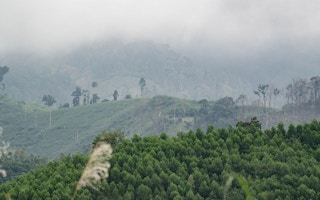Scientists believe they’ve uncovered a tipping point in the deforestation of landscapes across Earth: Once an area loses half its forest, the rest of the forest is often swift to fall.
Deforestation of the first half takes more time, as humans chip away the forest to create hodgepodges of forests and agricultural lands, for example, or as anthropogenic climate change levels its effects, the researchers reported in the journal Geophyscial Research Letters on Dec. 3.
“You would expect people would create more fragmentation, but as it turns out, people never stop,” Tomasz Stepinski, a physicist at the University of Cincinnati in the U.S. and one of the paper’s authors, said in a statement. “They convert the entire block on a large scale.”
Even the natural causes of these transitions are more apt to lead to uniform landscapes rather than mosaics, Stepinski said.
“Planet Earth wants to be homogeneous. The land wants to be the same in all these patches,” he said. “And when they start to change, they don’t stop until they convert everything into another homogeneous block.”
Using satellite maps from the European Space Agency, Stepinski and fellow author Jakub Nowosad, a former postdoctoral scholar at the University of Cincinnati, plotted out 9-by-9-kilometre (5.6-by-5.6-mile) squares across Earth’s surface and identified 64 landscape combinations present in these blocks.
They then analysed the changes that occurred in these areas between 1992 and 2015. Over that period, about 15 per cent of them made near-complete transitions from one type to another.
Stepinski and Nowosad also wanted to understand how these transitions might occur in the future, so they built a statistical model using the forest-to-farmland transition as a case study.
Still, the application of the model to other transitions might help reveal other tipping points as well, said Nowosad, now an assistant professor in geoecology and geoinformation at Adam Mickiewicz University in Poland.
“This model can be used to help understand how landscapes evolved and are going to evolve in the future,” he said.
Even the just over two decades of data that the scientists looked at could provide clues to the sorts of landscape transitions that Earth and its inhabitants are in for, Stepinski said.
“That’s a relatively short period of time. But from that we can calculate change in the future,” he said.
The strategy is similar to the way that his former colleagues at NASA study astrophysics, Stepinski added.
“If you look at the evolution of stars, the principle is you predict a long-term path statistically from short-term knowledge,” he said. “It’s an idea that has been used elsewhere but never for environmental study.”
Though this research didn’t look at the causes of the landscape changes, Stepinski suspects that the cascade of deforestation gains momentum as the forest becomes more accessible.
“I would imagine two things are happening,” he said. “If you are cutting forest, you have the infrastructure to finish it. It’s so much easier to cut the rest. Second, the forest is more vulnerable to change when there has been a disturbance.”
The pair writes that this knowledge lends support to conservation efforts aimed at protecting standing forests — and the species they support.
“You’d be hard pressed to find land managers who wouldn’t be strongly in favor of protecting larger tracts because they’re more resilient to a variety of challenges, including invasive species and climate change,” said Martin McCallister, a project manager for the Edge of Appalachia Nature Preserve in the U.S.
McCallister, who was not involved in the research, added, “Once a property gets fragmented by roads, it’s easier to extract resources. It’s also easier for invasive species and pests to get a foothold.”
This story was published with permission from Mongabay.com.










